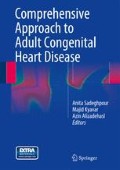Abstract
Recent advances in the image quality of magnetic resonance imaging and cardiac computed tomography have challenged the role of heart catheterization in the management of adult patients with congenital heart disease (CHD). Indeed, the indications for diagnostic catheterization have been reduced to three major ones:
-
1.
Complete anatomic diagnosis or necessary hemodynamic information cannot be obtained by noninvasive methods.
-
2.
Clinical signs and symptoms are not consistent with the patient’s diagnosis.
-
3.
The patient’s clinical course is not progressing as expected.
On the other hand, catheterization is the only gold standard for hemodynamic measurement and saturation study in adult patients with CHD. Furthermore, catheterism is drawn upon in the management planning for the measurement of pulmonary artery pressure, pulmonary artery resistance, pulmonary vasculature reactivity, and shunt calculations. What is more, pulmonary arterial pressure and pulmonary vascular resistance should be evaluated in patients with pulmonary hypertension, and it is necessary to conduct the challenge test with O2 or NO for the evaluation of pulmonary vascular resistance in a borderline patient. Angiography can evaluate the shunting site (if present), magnitude of left-to-right and right-to-left shunting, and significance of the defects. Chamber angiography is another important part of angiography in this field, requiring the operator’s in-depth knowledge of the anatomy of the heart in order to choose the best projection and obtain further necessary information. Coronary anomalies are quite frequent in adult patients with CHD. If the origin of the coronary artery is abnormal, the operator should seek to define the course of the coronary artery as well.
In a nutshell, aside from a thorough understanding of the structural anatomy of the heart, the operator should know the patient’s previous medications and interventions to be able to obtain valuable information during catheterization.
Access this chapter
Tax calculation will be finalised at checkout
Purchases are for personal use only
References
Gatzoulis MA, Webb GD, Daubeney P. Diagnosis and management of adult congenital heart disease. 2nd ed. Philadelphia: Elsevier Saunders; 2011. p. 68–85.
Deanfield J, Thaulow E, Warnes C, et al. Management of grown up congenital heart disease. The Task Force on the Management of Grown up Congenital Heart Disease of the European Society of Cardiology. Eur Heart J. 2003;24:1035–84.
Allen HD, Driscoll DJ, Shaddy RE, et al. Moss and Adams’ heart disease in infants, children, and adolescents including the fetus and young adult. 7th ed. Philadelphia: Lippincott Williams & Wilkins; 2008. p. 208–39.
Freedom RM, Mawson JB, Yoo SJ, et al. Congenital heart disease textbook of angiocardiography. Armonk: Futura Publishing; 1997. p. 39–93.
Freedom RM, Mawson JB, Yoo SJ, et al. Congenital heart disease textbook of angiocardiography. Armonk: Futura Publishing; 1997. p. 189–218.
Amplatz K, Moller JH, Castaneda-Zuniga W, Finch ME. Radiology of congenital heart disease. 1st ed. New York: Theime Medical Publisher; 1986. p. 131–9.
Mullins CE. Transseptal left heart catheterization: experience with a new technique in 520 pediatric and adult patients. Pediatr Cardiol. 1983;4:239–46.
Bergersen L, Forster S, Marshall AC, Meadows J. Congenital heart disease, the catheterization manual. 1st ed. New York: Springer; 2009. p. 4–8.
Ganz W, Donoso R, Marcus HS, et al. A new technique for measurement of cardiac output by thermodilution in man. Am J Cardiol. 1971;27:392–6.
Vargo TA, et al. Cardiac catheterization: hemodynamic measurements. In: Garson A et al., editors. The science and practice of pediatric cardiology. 2nd ed. Baltimore: Williams & Wilkins; 1998. p. 961–93.
Brown LK, et al. Anatomic landmarks for use when measuring intracardiac pressure with fluid-filled catheters. Am J Cardiol. 2000;86(1):121–4.
Freed MD, Miettinen OS, Nadas AS. Oximetric detection of intracardiac left-to-right shunts. Br Heart J. 1979;42:690–4.
Lister G, Hoffman JI, Rudolph AM. Oxygen uptake in infants and children: a simple method for measurement. Pediatrics. 1974;53(5):656–62.
LaFarge CG, Miettinen OS. The estimation of oxygen consumption. Cardiovasc Res. 1970;4(1):23–30.
Gutgesell HP, Williams RL. Caval samples as indicators of mixed venous oxygen saturation: implications in atrial septal defect. Cardiovasc Dis. 1974;1(3):160–4.
Krouskop RW, et al. Accuracy and clinical utility of an oxygen saturation catheter. Crit Care Med. 1983;11(9):744–9.
Mullins CE. Cardiac catheterization in congenital heart disease: pediatric and adult. Malden: Blackwell; 2006. p. 289–324.
Hill KD, Lim DS, Everett AD, et al. Assessment of pulmonary hypertension in the pediatric catheterization laboratory: current insights from the Magic registry. Catheter Cardiovasc Interv. 2010;76:865–73.
Greenberg MA, Fish BG, Spindola-Franco H. Congenital anomalies of the coronary arteries. Radiol Clin North Am. 1989;27:1127–46.
Ishikawa T, Brandt PWT. Anomalous origin of the left main coronary artery from the right anterior aortic sinus: angiographic definition of anomalous course. Am J Cardiol. 1985;55:770–6.
Author information
Authors and Affiliations
Corresponding author
Editor information
Editors and Affiliations
Rights and permissions
Copyright information
© 2014 Springer-Verlag London
About this chapter
Cite this chapter
Mohammadzadeh, S., Mahdavi, M. (2014). Cardiac Catheterization in Congenital Heart Disease. In: Sadeghpour, A., Kyavar, M., Alizadehasl, A. (eds) Comprehensive Approach to Adult Congenital Heart Disease. Springer, London. https://doi.org/10.1007/978-1-4471-6383-1_16
Download citation
DOI: https://doi.org/10.1007/978-1-4471-6383-1_16
Published:
Publisher Name: Springer, London
Print ISBN: 978-1-4471-6382-4
Online ISBN: 978-1-4471-6383-1
eBook Packages: MedicineMedicine (R0)

